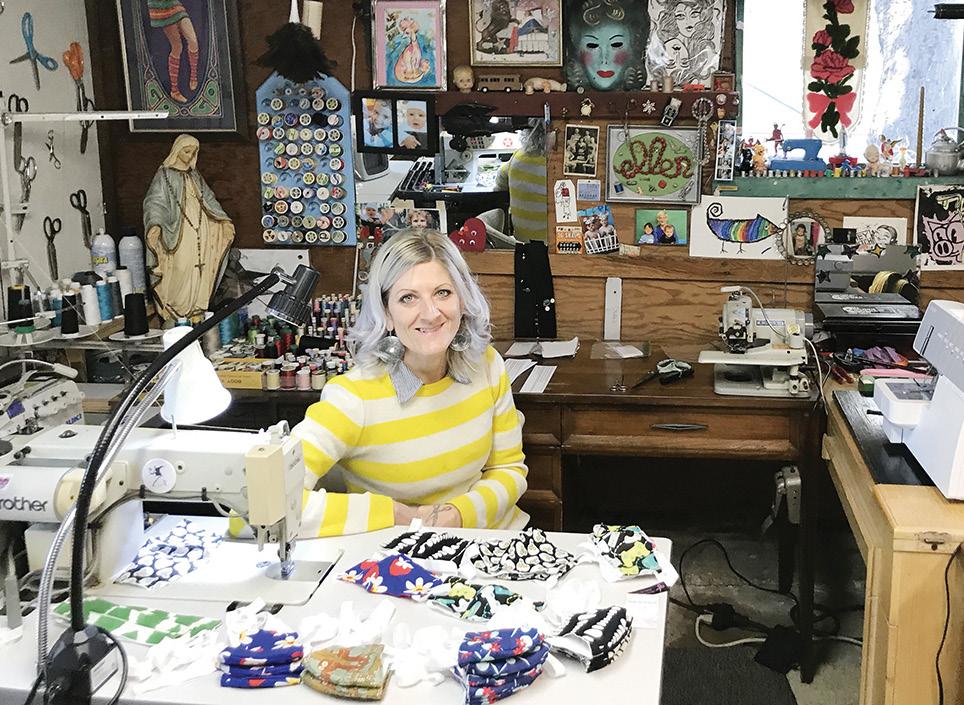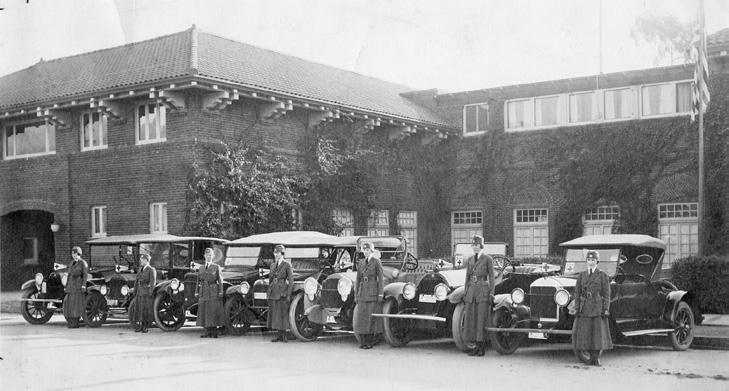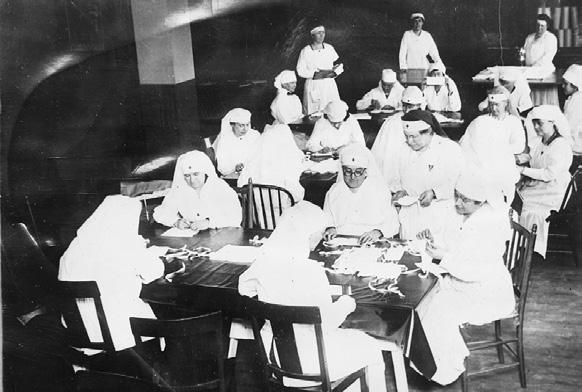
14 minute read
On the Record



2 – 9 April 2020 MONTECITO JOURNAL22 “Don’t wait. The time will never be just right.” – Napoleon Hill ON THE RECORD Page 374 Friendship Center, Easy Lift, and Bucket Brigade Team Up for Home Food Deliveries Nicholas Schou is an award-winning investigative journalist and author of several books, including Orange Sunshine and Kill the Messenger. If you have tips or stories about Montecito, please email him at newseditor@montecitojournal.net ON THE RECORD Nicholas Schou S ince 1979, Montecito’s nonprofit Friendship Center has provided group therapy for senior citizens from Monday through Friday at its rustic headquarters on Eucalyptus Lane. Normally by mid-morning on a weekday, the center would be a buzz of activity, with caregivers dropping off members to enjoy a day full of live music, therapy dog yoga, talks on travel and exploration, walking and water-coloring clubs, flower arranging and bingo, just to name a few. Last Thursday at 10 am, however, the Friendship Center was closed to the public, as it had been since March 15 thanks to the coronavirus pandemic. Despite this – or rather precisely because of this fact – about a dozen volunteers that morning packed the center to help deliver food and care packages to dozens of elderly members who are now stuck at home with nothing to do and nowhere to go. “We’ve been worried about our members and their caregivers ever since we closed both our Montecito and Goleta locations,” said executive director Heidi Holly, who along with Kim Larsen and Judy Hughes were wearing masks while busy packing bags of non-food items for members including stress balls, puzzles and games, shampoo bottles, Kleenex, and other small items donated by local businesses such as First American Title Company. “We felt it was important to take care of our members right now, because it’s hard for them to get out and get food, particularly for people who are in cognitive decline,” Holly said. “These are Take Care Totes that are filled with wellness and comfort food products so people can feel comfortable at home.”
To help deliver the food and care packages, the Friendship Center enlisted the support of Santa Barbara-based Easy Lift Transportation, a para-transit organization that helps bring elderly and disabled people anywhere they need to go from Goleta to Carpinteria, as well as provide free rides for MediCal recipients to and from medical appointments. On hand to help drive last Thursday was Easy Lift’s Kristina Lauterio, also wearing a mask. “We usually provide free transportation for people,” Lauterio told me. “Now we are here to deliver food.”
Holly was grateful for all the support. “Our mission is to keep people involved in activities to keep their minds going,” she explained. “So I really love that we are reaching out and being able to do that today, because their being home really concerns us. It’s hard on the caregivers and family members who take care of them when they are not here, and that’s why we are offering our help now, just to give them little things to do and keep them moving.”
Inside the Friendship Center’s kitchen were numerous boxes full of food staples including comfort food items such as bananas and pistachios as well as beans and other canned foods, all of which were provided to the center by the Foodbank of Santa Barbara. There to help organize the packing and delivery of the food was the Bucket Brigade’s Abe Powell, whose group has extensive experience in coordinating aid efforts. Powell made sure that volunteers practiced proper social distancing and helped ensure that as little effort as possible was wasted in packing up the food for delivery. “Line up these boxes right here,” Powell instructed. “Put the tables there and this is where all these boxes will go,” he added. “Boom!”
Along with all the other volunteers, Powell was wearing a health mask, but also a pair of industrial strength coveralls and heavy construction boots. “Normally, we run the entire operation ourselves,” he said after telling volunteers how to proceed. “But because we are working with all these other agencies with their own levels of experience and competence, we’ll get the system worked out. This is the premier barbacoa but we’ll get it right.” Santa Barbara’s Stitch Witch Now on Mask Duty A decade ago, after working at Nordstrom for several years, Ellen Sztuk took a lunch break one day and called up her husband, telling him she was going to quit her job. That night, when she came home from work, her husband asked her what she could possibly be thinking. “I told him that I am going to be the ‘Stitch Witch’ of Santa Barbara,” Sztuk recalls. “I made some business cards and in no time I had five clients. I realized this is what I am supposed to be doing my whole life.”
Born and raised in Salt Lake City, Sztuk has lived in Santa Barbara for the past 17 years. Although her great-aunt used to sew and she remembers learning Heidi Holly and Abe Powell readying the Friendship Center’s deliveries
Ellen Sztuk is the Stich Witch Items donated by the Food Bank of Santa Barbara Canned food to the rescue




STUNNING BIRNAM WOOD ESTATE 457 EASTGATE LANE | MONTECITO | 457EASTGATE.COM | $7,995,000
Nestled on 2+ acres in the exclusive enclave of Birnam Wood, this beautifully proportioned single-level home with its lush gardens evokes languid days in Provence. The private location with exceptional mountain and garden views offers the tranquil sophistication of Montecito. Built with impressive finishes, including tall ceilings, wide-plank walnut floors, bespoke cabinetry, customized lighting and abundant windows. A spacious entry hall flows to the dramatic living room with vaulted ceilings, a captivating dining room, and inviting kitchen/family room, all with French doors, leading to a spacious terraces and breathtaking gardens. The south wing houses a library and two generous en-suite bedrooms while the north wing offers a guest suite and office or forth bedroom.
Luxurious outdoor living with lush gardens, a soothing fountain, and a reflecting pool, plus a long swimmers pool, loggia and numerous relaxing spaces. Two oversized garages with generous motor court complete the property. This is a once in lifetime opportunity to acquire one of the finest properties at Birnam Wood Golf Club, featuring a renowned Robert Trent Jones golf course and historic Club house offering dining, tennis, fitness and social activities. 4 Bedroom | 3 Bath + 3 Half Baths
MAURIE MCGUIRE 805.403.8816 Maurie@MontecitoLand.com MontecitoLand.com CalRE #01061042
SCOTT WESTLOTORN 805.403.4313 Scott@MontecitoLand.com MontecitoLand.com CalRE # 01875690

Cottage Hospital with the Nurses’ Home (the original hospital) in the background was filled beyond capacity (Courtesy Santa Barbara Historical Museum)

started advertising the slogan, “Cover up each cough and sneeze; if you don’t, you’ll spread the disease.” They also arranged for public speakers and slides to be shown at the theaters in order to educate the public, they said, “into realizing a sense of the seriousness of the situation.” New York City did Santa Barbara one better and made it illegal to sneeze in a public place without covering one’s mouth and nose. The penalty? Five hundred dollars or one year in jail, or both!
On October 13, another local boy, William E. Hosmer, died at Camp Humphrey, Virginia. Several cases of colds and mild influenza were reported in town, but officials claimed there was no cause for panic.
On October 15, everything changed. The Santa Barbara Board of Health, under the direction of George H. Hicks, closed the schools, churches, and all public places and forbade all public gatherings. Houses where family members were ill with influenza were quarantined and placarded as such.
The number of cases built slowly, but soon Cottage Hospital, County General, and St. Francis were full. The demand for space became so severe that the not-yet-finished maternity ward was pulled into service as were the basement, new dispensary, and the parlor at the nurses’ home.
Prynce Hopkins was the pacifist founder of Boyland (later the Samarkand Hotel and today a retirement community), a boarding school for underprivileged boys. He had been fined $20,000 and jailed for his anti-war lectures. Public sentiment against Hopkins had closed his school by the spring of 1918, nevertheless, he offered the empty building as an emergency hospital for the duration of the epidemic. It opened on October 22. Besides lack of space, qualified nurses were in short supply because many were serving overseas. Red Cross volunteers filled in where needed. Eventually, public school teachers were required to work for the war effort, the flu effort, or the schools in some capacity.
The Fight Against the Virus
On October 19, Santa Barbara experienced its first death from influenza, followed the next day by two more. On October 20, the number of cases in California stood at 15,363 reported cases with Santa Barbara reporting 152. On October 23, the California State Board of Health ordered barbers and hotel room attendants to wear medicated gauze masks. Local banks initiated a voluntary mask plan as did several postal clerks. The Morning Press reported, “The appearance of the masks here was in many ways a severe jolt to the skeptical ones who
SITE DRAINAGE SYSTEMS
50 + YEARS EXPERIENCE - LOCAL 35+ YEARS
• FLOOR LEVELING • QUALITY REMODELING • FOUNDATION REPLACEMENTS • FOUNDATIONS REPAIRS • NEW CONSTRUCTION • RETAINING WALLS • FRENCH DRAINS – WATERPROOFING • SITE DRAINAGE SYSTEMS • UNDERPINNINGS – CAISSONS • STRUCTURAL CORRECTION WORK • CONCRETE DRIVEWAYS
J ARROTT & CO.
REAL E S T A T E INV E S T MENT S
SPECIALIZING IN 1031 TAX-DEFERRED EXCHANGES AND TRIPLE NET L EASED INVESTMENT PROPERTIES WITH NATIONAL TENANTS MANAGEMENT FREE
CALL Len Jarrott, MBA, CCIM 805-569-5999 http://www.jarrott.com have been laboring under the delusion that there was nothing at all to the Spanish influenza scare.”
The Red Cross made and distributed 1,400 flu masks. Once those were gone the Board of Health offered sterilized cheesecloth so the citizens could make their own. “This is a very simple matter,” they said. “Even a man can make them.” The State Board of Health ordered all people ill with the flu or a cold and their family members to wear masks as well as all medical staff and visitors to hospitals.
The mask requirements did not go unchallenged. In Santa Barbara, people simply ignored the ordinance; in San Francisco, they were vocal about it. Several wrote the papers and the mayor saying it was unconstitutional. One man, Erminio Chavez, Sr., asserted masks frightened people, encouraged municipal corruption, discouraged immigration, enabled married folks to deceive each other, and pleased the Kaiser.
By October 27, the emergency hospital at Boyland was filled, and 9 people had died. On that day, the Morning Press headline shouted, “BAN ON GHOSTS PROWLING AROUND,” and Halloween activities were cancelled. Merchants wrote, admonishing their customers to use the phone if they were sick and not “subject clerks and employees to the annoyance and possible danger of being forced to wait on customers with incipient cases of influenza.”
As activities of a social nature ceased, the society editor Jessie Mary Bryant wrote, “Just as long as this epidemic lasts, with incidental fall in activities of all kinds, I am afraid I shall have to administer an occasional dose of poetry.”
On November 5, the Board of Health ordered all people riding streetcars, auto buses, taxicabs, or other forms of public transportation to wear a mask. The death toll accelerated. Four of 20 Santa Barbara boys who went to train for army auto school died of influenza. Peter Morales and Joseph Ross died at Boyland, and Jesus Maria was picked up on the street by the police. He was ill with pneumonia, weak and suffering from a temperature of 104 degrees. They took him to the emergency hospital.
Anti-flu serums developed in the Montecito laboratory of Dr. Potter and those developed elsewhere were offered to the public, but there were few takers. One self-styled epidemiologist said the quickest and easiest antidote to the flu was to splash about in the salty surf of the Pacific until the tides came in. Another claimed that kerosene could be used as a germicide. One drop on the tongue and a slight touch in the entrance of the nostrils four times a day would do the trick. One man tried it and said that other than being afraid to light a match, he was all right. Dr. K.F. Winchester claimed a sure cure was to use wintergreen, which would destroy bacteria. Despite these bromides, on November 10, Police Chief Lester Desgrandchamp announced that the police would arrest those who disobeyed the face mask rules while riding public transport. A total of 225 new cases had been reported that past week.
Finally the number of new cases Boyland, Prynce Hopkin’s school for underprivileged boys, became a hospital ward (Courtesy Santa Barbara Historical Museum)
DADIANA
SALON • COSMETICS • NAILCARE • FRAGRANCE • BATH & BODY GIFTS • HAIRCUT, COLOR AND HIGHLIGHT SPECIALIST
Red Cross Motor Pool in front of the Recreation Center where volunteers switched from rolling bandages to making masks (Courtesy Photo)


Throughout the nation, Red Cross volunteers made masks to protect people from the pandemic (Library of Congress)
abated, and on December 4, the Morning Press reported, “The Last of the Flu Fences Knocked Down.” The epidemic, like the war, was over just in time for Christmas. In Santa Barbara and Montecito, crowds rejoiced and prepared to welcome home their soldier boys, women prepared to vote and serve on the grand jury, and everyone drank “one more for the road” before getting on the wagon of Prohibition.
A Merry Christmas and a Not-So-Happy New Year
After a very merry Christmas of mingling with friends and family and kissing under the mistletoe, the Board of Health greeted the New Year by closing the city again. The Morning Press of January 3 reported 35 new cases of influenza with an average of 33 new cases per day the entire previous week.
With Boyland now closed, a new emergency hospital was opened by the Red Cross in the Hadley House at 633 East Sola Street. The house was donated by its artist owner, Louis Lombard. The Red Cross put out a call for Gray Ladies, volunteer nurses who had taken the home nursing course, and assumed all costs of running the hospital.
The death toll continued to rise. Ray Leslie of Montecito died January 3, three others on January 4 and deaths continued to average about three per day for the next few weeks.
With school closed again, the Board of Education instituted a correspondence system for students. The St. Cecilia Club, which was helping fund several cases of influenza, canceled its annual fundraiser, the Valentine’s Day Tea and Fair, just when it needed it the most.
Clarence Black’s daughter Ruth as a member of the Red Cross Motor Pool which extended its service beyond the Armistice (Courtesy Photo)

A flying squadron of quarantine cops joined the Red Cross Motor Pool in aiding the health board. They patrolled the city on motorcycles, putting up notices of influenza on quarantined houses, getting doctors and nurses for the sick, performing errands for quarantined families, and enforcing the quarantine.
By January 29, the Health Board decided the crisis had passed and cautiously phased in a partial opening of the city. First the schools were reopened, then the churches, and finally the theaters and pool halls. By February 11, the final flu bans were removed as the epidemic sputtered out.
To this day, scientists remain baffled by the 1918 Influenza Pandemic. They have not been able to determine its origin or pathology. They do know that its severity serves as a great lesson and warning as medical workers the world over struggle to plan for the next “Big One.”
(Sources: contemporary Morning Press and Daily News articles; “1918 Influenza: the Mother of All Pandemics” by Jeffrey K. Taubenberger and David M. Morens; “Philadelphia Nurses, and the Spanish Influenza Pandemic of 1918” by James F. Armstrong, U.S. navy; “Santa Barbara History Makers,” and “Cottage Hospital: the First 100 Years” by Walker Tompkins; with special thanks to C. Seybert Kinsell, MD.) •MJ












